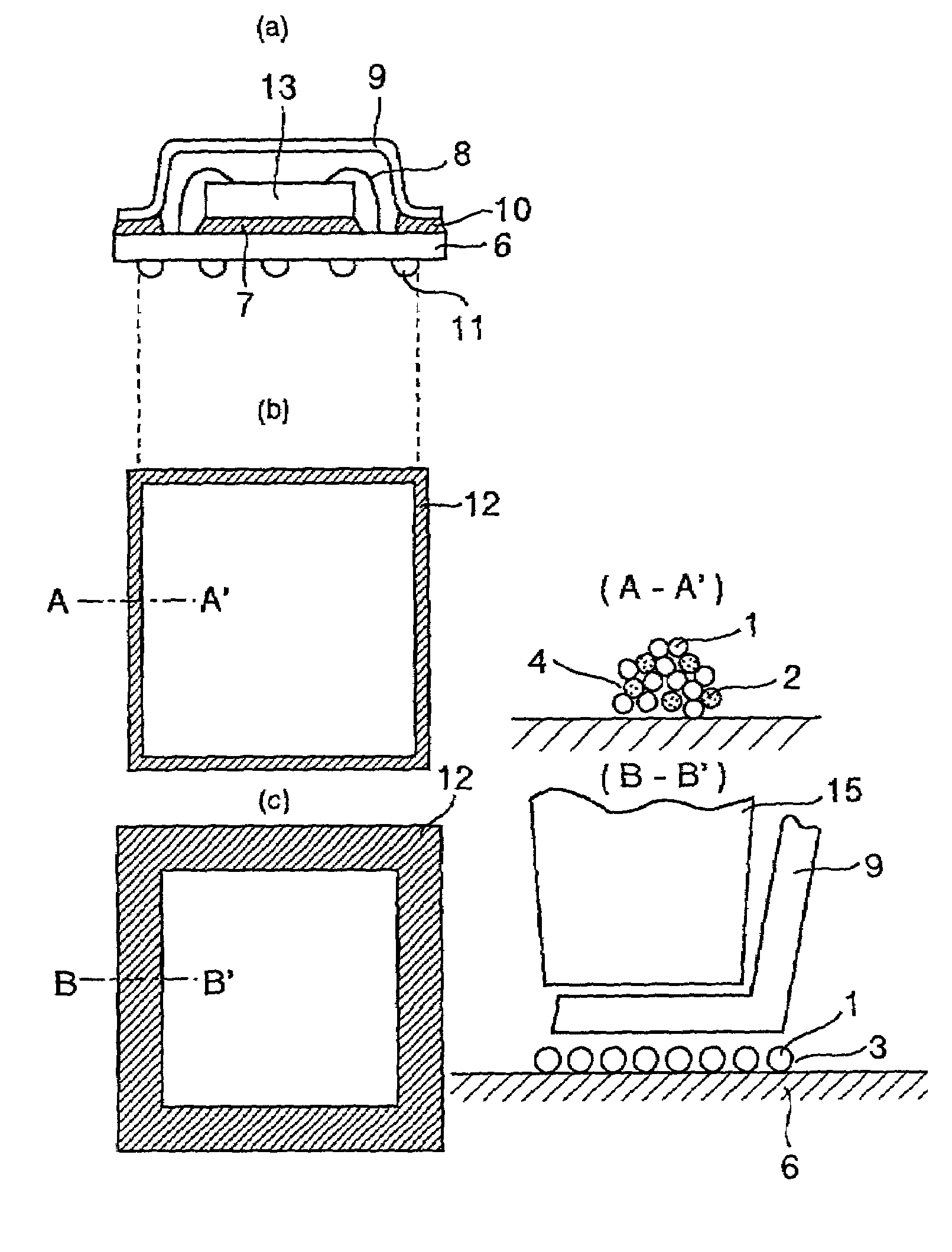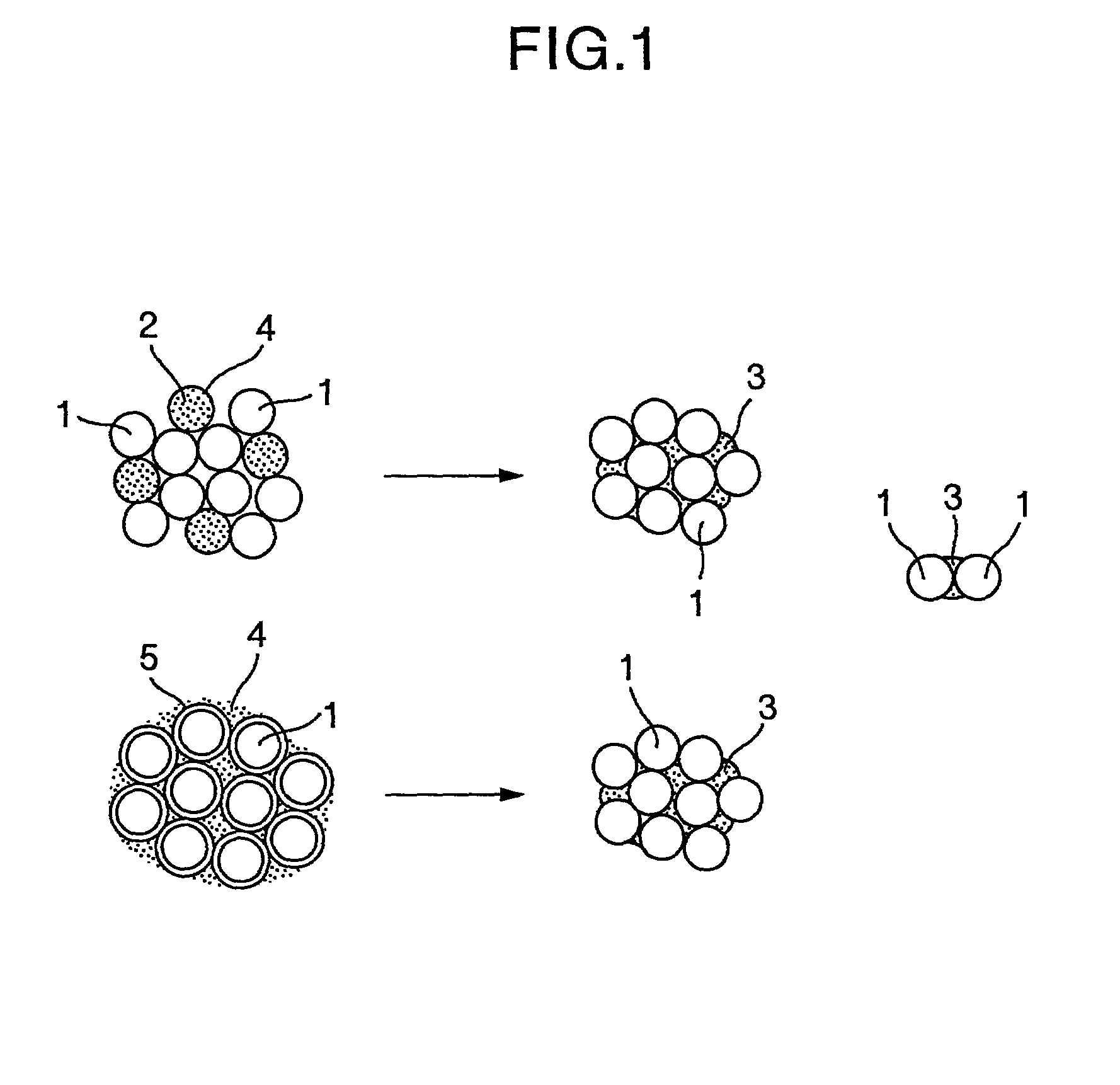Electronic device
a technology of electronic devices and components, applied in the field of electronic devices, to achieve the effect of high melting point of intermetallic compounds, sufficient bonding strength, and sufficient bonding strength
- Summary
- Abstract
- Description
- Claims
- Application Information
AI Technical Summary
Benefits of technology
Problems solved by technology
Method used
Image
Examples
embodiment 1
[0052]FIG. 1 shows the concept of a bonding structure relating to the invention. This figure also shows a condition before soldering and another condition after soldering. The upper portions of FIG. 1 shows an example of use of a paste in which Cu balls 1 with a particle size of about 30 μm (or balls of Ag, Au, Cu—Sn alloys, etc., or those to which an Au plating, and Ni / Au plating, etc., are applied, or those to which an Sn plating, etc., are applied) and Sn solder balls 2 (melting point: 232° C.) with a particle size of about 30 μm are appropriately dispersed in small quantities via a flux 4. When this paste is subjected to reflow at a temperature of not less than 250° C., the Sn solder balls 2 melt, molten Sn 3 spreads so that it wets the Cu balls 1 and becomes present between the Cu balls 1 relatively uniformly. The Cu balls need not be spherical; that is, Cu balls having great surface irregularities, bar-like ones, and those containing dendrite crystals may be used. In this case...
embodiment 2
[0057]In FIG. 2(a), a semiconductor device 13 is bonded to a junction substrate 6 by use of an Au-20Sn solder, etc. and after wire bonding 8, the peripheral portion of a cap 9, which is fabricated by plating Al, Fe—Ni, etc. with Ni—Au, is bonded 10 to the junction substrate by reflow through the above solder paste of non-cleaning type. On this occasion, when the insulating characteristic is regarded as important, it is desirable to perform bonding in a nitrogen atmosphere by use of a solder with a flux not containing chlorine. However, when the wettability cannot be ensured, the encapsulation with a weak-activity rosin of RMA type may be performed. This semiconductor device is not required to have a perfect encapsulatability and, therefore, if the flux has adequate insulating characteristics, there occurs no influence of holding for a long time on the semiconductor device even in the presence of the flux. The purpose of the cap encapsulation is mainly mechanical protection. As a met...
embodiment 3
[0063]The paste relating to the invention can also be used in the die bonding 7 shown in FIG. 2(a). After bonding by use of the paste relating to the invention, cleaning and wire bonding are performed. In prior arts, the die bonding is performed by use of an Au-20Sn solder, however, it has been limited to small chips in view of reliability. Also, in the case of Pb-base solders, a Pb-10Sn solder, etc., have been used. The bonding relating to the invention can be used even in chips having a somewhat larger area. The larger the thickness of a bonding portion, the longer the service life and the higher the reliability become. In the invention, it is possible to make this thickness larger by using high melting point balls each having a larger size. In a case of making this thickness small, this is performed by making the size of particles (, that is, balls) small. In some bonding methods, it is also possible to use a thin bonding portion by reducing the particle size. Even Cu particle si...
PUM
| Property | Measurement | Unit |
|---|---|---|
| diameter | aaaaa | aaaaa |
| melting point | aaaaa | aaaaa |
| temperatures | aaaaa | aaaaa |
Abstract
Description
Claims
Application Information
 Login to View More
Login to View More - R&D
- Intellectual Property
- Life Sciences
- Materials
- Tech Scout
- Unparalleled Data Quality
- Higher Quality Content
- 60% Fewer Hallucinations
Browse by: Latest US Patents, China's latest patents, Technical Efficacy Thesaurus, Application Domain, Technology Topic, Popular Technical Reports.
© 2025 PatSnap. All rights reserved.Legal|Privacy policy|Modern Slavery Act Transparency Statement|Sitemap|About US| Contact US: help@patsnap.com



